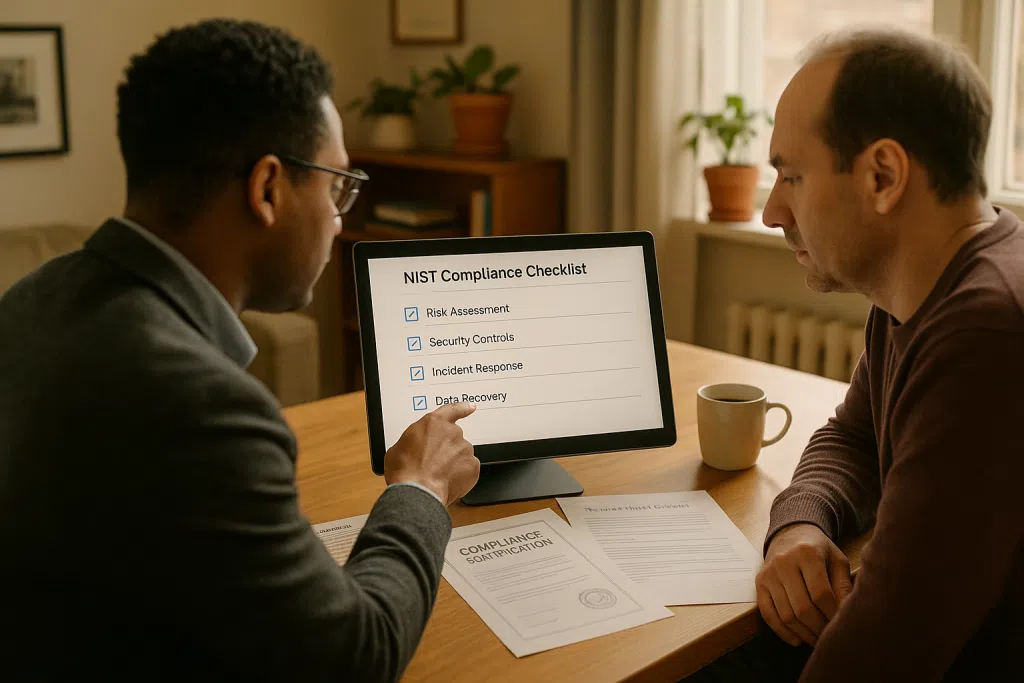Cybersecurity is not just an IT concern for today’s small and mid-sized businesses, it’s a business necessity. Yet many organizations in healthcare, finance, legal, and other regulated industries across New Jersey and beyond find themselves overwhelmed by the steps necessary to reach and maintain compliance with stringent frameworks like the National Institute of Standards and Technology (NIST) Cybersecurity Framework. The NIST compliance checklist offers a clear, actionable roadmap for organizations committed to cybersecurity compliance, safeguarding sensitive data, and meeting evolving regulatory demands. Whether your business is preparing for a third-party SOC 2 audit, conducting a PCI DSS self-assessment, or updating a HIPAA risk analysis, integrating the NIST compliance checklist can help streamline your compliance journey without the headaches or confusion of technical jargon.
Ready to help your business build a solid cybersecurity foundation based on NIST guidelines? Book an initial Discovery meeting to discuss your compliance needs and get tailored guidance: Schedule with Blueclone Networks.
Understanding NIST: Why This Framework Matters for Modern Businesses
NIST, or the National Institute of Standards and Technology, is a non-regulatory federal agency within the U.S. Department of Commerce. Over the years, NIST has developed some of the most widely adopted standards and frameworks for cybersecurity, and for good reason. The NIST Cybersecurity Framework (CSF) provides a flexible, easily adapted structure for managing cybersecurity risk. It is not just for large enterprises or government contractors. SMBs in regulated industries are increasingly called to demonstrate cybersecurity due diligence, making a practical NIST compliance checklist crucial.
Regulators in healthcare (HIPAA), finance (GLBA), payments (PCI DSS), and other sectors often reference NIST guidelines as a benchmark for best practices, even when not strictly required by law. For example, the HIPAA Security Rule crosswalks to NIST controls, and many financial regulatory agencies cite NIST’s standards for risk assessment. The adoption of these controls has steadily climbed: according to Datto’s 2025 SMB Cybersecurity Report, over 60% of mid-sized businesses in the U.S. now align part of their cybersecurity program with the NIST CSF or related frameworks.
NIST’s value lies in its structure. The CSF breaks down cybersecurity into five essential “Functions”: Identify, Protect, Detect, Respond, and Recover. These are further divided into categories and subcategories. The NIST compliance checklist builds directly from these practical elements, outlining policies, controls, and documentation requirements in a language business leaders and IT teams can actually use.
Beyond regulatory alignment, following a NIST compliance checklist demonstrates proactive data security to clients, insurance providers, and business partners. When structured and communicated effectively, this approach gives confidence to executive leadership and reassures internal teams that cybersecurity risks are being managed, not ignored.
A discovery session can uncover how NIST-based compliance and cybersecurity can specifically impact your organization’s operational goals. Take the first step and book a session now.
Building Your NIST Compliance Checklist: Components and Best Practices
Effective compliance is about more than checking boxes on a regulatory compliance checklist. A NIST compliance checklist covers policies, technical safeguards, evidence-building documentation, and ongoing maintenance, each tailored to your organization’s size, risk profile, and industry requirements.
1. Identification: Inventory, Risk Assessment, and Asset Management
Asset Inventory: A foundational step, catalog all digital assets in your environment: laptops, servers, cloud services, user accounts, software, and even IoT devices. Many breaches root from unmanaged assets. Consider using automated tools to keep this inventory up to date, a requirement on both the NIST compliance checklist and standards like the SOC 2 compliance checklist.
Business Environment Analysis: Clearly document your organization’s mission, processes, and supporting systems. This context helps drive prioritization; not all risks are equal. Engaging business managers ensures the risk profile reflects real-world operations.
Governance and Policy: Define cybersecurity roles, responsibilities, and oversight. Ensure executive leadership supports required resources. Are policies for information security, data retention, and third-party risk management documented, communicated, and approved?
Risk Assessment: Identify potential threats, malware, ransomware, insider errors, and third-party risks against your unique business ecosystem. Use both qualitative and quantitative methods as suggested in the NIST Risk Management Framework (RMF). Periodically repeat this assessment, as threats and technology change.
Risk Management Strategy: Establish how identified risks will be handled: accept, mitigate, transfer (for example, with cybersecurity insurance), or avoid. A written, board-approved risk management strategy is foundational for audit readiness.
2. Protection: Safeguards, Controls, and Training
Access Control: Enforce least privilege across your network. Define who can access sensitive files and systems, and implement multifactor authentication. Periodically audit user accounts and permissions, an action appearing on nearly every data security checklist.
Awareness and Training: Train all staff on cybersecurity basics like phishing, password hygiene, and safe use of cloud solutions. Regulators increasingly consider training completion rates and content when evaluating a compliance program.
Data Security: Encrypt sensitive data at rest and in transit, using protocols that are considered secure by current NIST standards. Encryption is a non-negotiable in HIPAA compliance checklists and PCI DSS compliance checklists alike.
Configuration Management: Secure all hardware and software. Apply vendor-recommended security patches promptly. Document baseline secure configurations and automate drift detection where possible.
Maintenance: Set structured patching and maintenance schedules. Keep evidence of completed patch cycles, and address out-of-support software.
Information Protection Processes: Back up business-critical data regularly, test restoration, and verify all backup copies are stored securely, preferably offsite or in the cloud.
Protective Technology: Use firewalls, endpoint protection, intrusion detection systems, and multi-layered email security. Document technology selection and update cycles in line with business changes.
Implementing these protections with a business-focused mindset, not just technical requirements, builds resilience and meets the expectations set by the NIST compliance checklist. By approaching these safeguards as business enablers, organizations encourage buy-in from staff at every level.
Key Steps for Detecting and Responding to Security Events
A NIST compliance checklist does not stop at prevention. It insists on preparedness to both detect incidents early and respond efficiently, which is crucial to minimizing disruption and regulatory exposure.
3. Detection: Monitoring, Logging, and Alerting
Continuous Monitoring: Set up centralized, real-time monitoring for your IT environment. This may involve security information and event management (SIEM) tools, log aggregation, and alerting for suspicious activity. According to IBM’s 2025 Cost of a Data Breach Report, organizations with robust detection programs minimize average breach costs by nearly 30% compared with those lacking detection capabilities.
Anomaly Detection: Define what “normal” looks like for network and system activity. Establish alerts for changes like unexpected login times, blocked USB device connections, or sudden spikes in data transfers, clear signals noted in both the NIST and SOC 2 compliance checklists.
Event Logging: Enable audit logs for critical systems, applications, and cloud platforms; collect logs offsite and secure against tampering. Log review requirements show up in every regulatory compliance checklist, and auditors will expect concrete evidence of consistent log monitoring.
Incident Reporting: Create simple, clearly communicated reporting procedures. Staff should be able to quickly escalate suspicious activity without fear of blame. Track reported incidents, response actions taken, and lessons learned.
4. Response: Incident Management and Communication
Incident Response Planning: Document an incident response plan mapping out roles, escalation procedures, communication flows, and decision authority. Test your plan through tabletop exercises and update it after significant events or technology changes.
Communications Strategy: Define how and when to communicate incidents internally and, when required, to regulators, clients, or law enforcement. This is a must for regulated industries like healthcare and finance, where breach notification timelines are legally defined.
Analysis and Mitigation: Investigate each incident to understand the root cause and prevent recurrence. Document each step and outcome; this evidence is critical for compliance and insurance claims.
Improvements: Update security policies, controls, and training after incidents. The NIST compliance checklist requires ongoing adaptation, not just a one-time effort.
Both detection and response should be integrated throughout your business operations, not siloed. For more complex environments or where in-house expertise is limited, many organizations choose to collaborate with a managed IT provider to gain cost-effective, real-time support and expertise.
How Recovery and Documentation Complete Your Compliance Journey
5. Recovery: Restoring Operations and Evidence Collection
Recovery Planning: Prepare and document detailed recovery plans for critical systems. These plans should cover manual workarounds, restoration priorities, and communication workflows. Disaster recovery and business continuity are core elements in the NIST and HIPAA compliance checklists.
Testing and Updating: Conduct regular recovery tests, at least annually, but ideally after every major system change or incident. Update recovery plans based on lessons learned and new threats.
Improvement Logging: After each incident or test, keep records of what worked and what did not. Build a prioritized list of improvements and assign responsibilities for completion.
Communications After Recovery: Keep relevant stakeholders, including clients and regulators if necessary, informed of recovery progress and verification of restored security.
Documentation: Maintain comprehensive records for every step and decision in your cybersecurity program. Documentation is not only a cornerstone of the NIST compliance checklist but also directly supports audits for frameworks like SOC 2, HIPAA, and PCI DSS.
This step ensures your organization doesn’t just recover from disruptions but learns from them, and can demonstrate due diligence during periodic audits.
To learn how recovery planning can be tailored to your organization, especially if you’re integrating cloud-based services or AI workflows, book a discovery meeting today.
Bridging the Gap: Integrating Regulatory Checklists with NIST
Each regulation, HIPAA, PCI DSS, SOC 2, and others, has specific controls, but there’s considerable overlap when mapped against the NIST compliance checklist. Streamlining compliance activities using a single risk-based framework reduces duplication, administrative costs, and confusion.
HIPAA Compliance Checklist: The HIPAA Security Rule cross-references directly to NIST categories. For example, NIST’s access control, audit log, and incident response requirements form the foundation for health data security compliance.
PCI DSS Compliance Checklist: Payment environments also benefit from NIST-advised security engineering, strong encryption, constant network monitoring, and strict access management. Many merchant processors now reference NIST password guidance specifically.
SOC 2 Compliance Checklist: Auditors expect controls for availability, confidentiality, and privacy, all of which align to NIST’s categories. Evidence documentation, such as policy updates, log reviews, and incident reports, can be served from your NIST-based process.
Regulatory Compliance Checklist Convergence: By adopting the NIST framework as an anchor, you can streamline policies, standardize evidence collection, and reduce the complexity of supporting multiple similar audits. According to the National Law Review, organizations with harmonized compliance programs see an estimated 40% fewer audit-request-related delays.
Data Security Checklist: The NIST checklist’s clear demands for endpoint protection, secure configuration, ongoing monitoring, and data encryption mean you’re always prepared for the data security scrutiny regulators and clients demand.
Blueclone Networks helps organizations design and operate comprehensive compliance programs anchored by NIST standards, integrating them with specific regulatory checklists for efficient, sustainable, and scalable results. For practical tips on harmonizing your compliance efforts, see the NIST Cybersecurity Framework’s resources, or check out Gartner’s latest compliance guides (2025).
Real-World Examples: Applying the NIST Compliance Checklist
Healthcare Practice Case: A multi-location medical group in Central NJ faced mounting pressure to document compliance with both HIPAA and local regulations. Rather than manage two checklists separately (HIPAA compliance checklist and NIST compliance checklist), they adopted NIST as the primary structure. By deploying a unified asset management tool, automating backup evidence for their EMR, and running incident response tabletop drills, they cut annual audit preparation time by 50% and avoided regulatory fines for gaps in log management.
Legal SMB Example: A Princeton law firm with a mix of remote and in-office staff needed to align with client-mandated SOC 2 compliance. Working off the NIST checklist, they improved user access reviews, trained all staff on social engineering risks, and pushed for multi-factor authentication on client file systems. This not only improved audit scores but also increased client trust during RFP processes.
Finance and Payments Example: A regional payments processor wanted to expand into healthcare clients, requiring both PCI DSS compliance and HIPAA protections. By mapping the PCI DSS compliance checklist against the NIST framework, they centralized policies, eliminated duplicate documentation, and simplified training for in-house and client-facing teams. This approach improved overall audit readiness and helped win a major hospital contract.
AI Integration and Co-Managed IT Example: For organizations embracing AI tools or co-managed IT partnerships, NIST-based compliance helps set clear boundaries on responsibilities (such as who patches which systems), ensures all data flows are documented, and provides for independent verification through regular risk assessments and audits.
Data-driven results like these showcase why the NIST compliance checklist is the preferred “language” of auditors, insurers, and forward-thinking leadership teams. They also highlight how practical, incremental improvements lead to lasting, secure business operations, rather than one-time fixes.
If you’d like to discuss a specific industry case study or see how these steps might look for your organization, don’t hesitate to set up a discovery session.
Frequently Asked Questions About the NIST Compliance Checklist
The NIST compliance checklist is a dynamic set of tasks, policies, and technical controls built from the NIST Cybersecurity Framework and Special Publications (like NIST SP 800-53). Its purpose is to guide organizations in assessing and improving their cybersecurity practices. Although initially designed for government agencies and contractors, it is now an industry best practice for businesses in regulated sectors such as healthcare, finance, legal, and any SMB seeking to improve data security and regulatory readiness.
NIST checklists offer a comprehensive, risk-based approach covering the entire cybersecurity life cycle: identification, protection, detection, response, and recovery. While HIPAA, PCI DSS, or SOC 2 compliance checklist items overlap with NIST requirements, those tend to focus tightly on sector-specific controls and prescriptive requirements. NIST provides a high-level framework that can serve as the backbone for harmonizing multiple compliance efforts, making it easier to manage evidence, policies, and reporting.
A modern cybersecurity compliance checklist, including NIST controls, should be revisited and updated at least annually or whenever there are significant changes to your IT environment (such as adding cloud services, integrating AI, or moving locations). Frequent updates are important when new threats emerge, so continuous risk management and regular compliance reviews are highly recommended.
Both policy and evidence-driven documentation are required. This includes written security policies, documented risk assessments, inventories of assets, user access reviews, audit logs, training completion records, incident response plans, and records of incident investigations and updates. Good documentation practices form the backbone of audit readiness across all major compliance frameworks.
It depends on staff expertise, available time, and risk appetite. Many small and mid-sized organizations start with in-house efforts but bring in specialized managed IT or compliance consultants to streamline the process, ensure no gaps exist, and support ongoing maintenance. External advisers often help reduce overall costs by building efficient, right-sized programs and reducing the chance of expensive audit findings.





